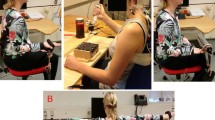Summary
The electromyographical (EMG) response to isometric ramp contractions of the right arm, the left arm, and both arms was studied using four pairs of surface electrodes above the right upper trapezius muscle (UT) of six men and six women. Contractions were made against gravity with the active arm(s) in eight positions, ranging from flexion to abduction. To describe arm positions, a new, simple terminology was developed. Root mean square (rms)-converted EMG-signals were normalized (EMGnorm) with respect to a reference contraction. The EMGnorm corresponding to a 15 N · m torque in the right glenohumeral (GH) joint was strongly related to the position of the right arm (P<0.001). The shape of this relationship depended on the electrode position (P<0.001). The ratio between EMGnorm at 30 N · m and 15 N · m GH torques was related to arm position (P < 0.001) and differed between electrodes (P< 0.001). A left-side GH torque resulted in right-side (contralateral) EMG activity, typically corresponding to 20%–30% of that obtained during similar right-side GH torque. Bilateral GH torque implied 0%50% increase in EMG activity as compared to that obtained with the right arm alone. The results have shown that signals from one pair of surface electrodes above UT cannot be taken as representative of the EMG activity from electrodes located elsewhere above UT. The EMG recordings reflected a complex pattern of muscular activation, significantly related to both outwardly visible factors (arm position, GH torque), and within-body servosystems (motor control reflexes).
Similar content being viewed by others
References
American Academy of Orthopaedic Surgeons (1965) Joint motion — method of measuring and recording. Churchill and Livingstone, Edinburgh
Armstrong TJ, Foulke JA, Joseph BS, Goldsteinn SA (1982) Investigation of cumulative trauma disorders in a poultry processing plant. J Am Ind Hyg Assoc 43:103–116
Barnes WS (1980) The relationship between maximum isometric strength and intramuscular circulatory occlusion. Ergonomics 23:351–357
Basmajian JV, DeLuca CJ (1985) Muscles alive. Williams and Wilkins, Baltimore
Brooks VB (1986) The neural basis of motor control. Oxford University Press, Oxford
Chaffin D, Andersson GBJ (1984) Occupational biomechanics. Wiley, New York
Gregg RA, Mastellone AF, Gersten JW (1957) Cross exercise — a review of the literature and study using electromyographic techniques. Am J Phys Med 36:269–280
Hagberg M (1981a) Work load and fatigue in repetitive arm elevations. Ergonomics 24:543–555
Hagberg M (1981b) Electromyographic signs of shoulder muscular fatigue in two elevated arm positions. Am J Phys Med 60:111–121
Hagberg M (1988) Arbetsmiljöns betydelse för besvär i skuldra och halsrygg (The significance of the working environment to shoulder-neck disorders) (in Swedish). Arbetsmiljöfonden, Stockholm
Hagberg M, Sundelin G (1986) Discomfort and load on the upper trapezius muscle when operating a wordprocessor. Ergonomics 29:1637–1645
Hagberg M, Wegman DH (1987) Prevalence rates and odds ratios of shoulder-neck diseases in different occupational groups. Br J Ind Med 44:602–610
Hägg G, Suurküla J, Liew M (1987) A worksite method for shoulder muscle fatigue measurements using EMG, test contractions and zero crossing technique. Ergonomics 30:1541–1551
Herberts P, Kadefors R, Broman H (1980) Arm positioning in manual tasks. An electromyographic study of localized muscle fatigue. Ergonomics 23:655–665
Högfors C, Sigholm G, Herberts P (1987) Biomechanical model of the human shoulder — 1. Elements. J Biomech 20:157–166
Inman VT, Saunders M, Abbott LC (1944) Observations on the functions of the shoulder joint. J Bone Joint Surg 26:1–30
Jonsson B (1978) Kinesiology. With special reference to electromyographic kinesiology. Contemp Clin Neurophysiol [EEG Suppl] 34:417–428
Jonsson B (1982) Measurement and evaluation of local muscular strain in the shoulder during constrained work. J Hum Ergol 11:73–88
Jarvholm U, Palmerud G, Styf J, Herberts P, Kadefors R (1988) Intramuscular pressure in the supraspinatus muscle. J Orthoped Res 6:230–238
Järvholm U, Palmerud G, Karlsson D, Herberts P, Kadefors R (1991) Intramuscular pressure and electromyography in four shoulder muscles. J Orthop Res (in press)
Jorgensen K, Winkel J (1987) On the bipartite function of the human soleus muscle. In: B. Jonsson (ed) Biomechanics X. Human Kinetics, Champaign, Ill., pp 259–264
Kadefors R, Petersén I, Herberts P (1976) Muscular reaction to welding work: an electromyographic investigation. Ergonomics 19:543–558
Lindman R, Eriksson A, Thornell LE (1991) The human male trapezius muscle; enzyme-histochemical characteristics. Am J Anat (in press)
Moore JC (1975) Excitation overflow: an electromyographic investigation. Arch Phys Med Rehabil 56:115–120
Schüldt K, Harms-Ringdahl K (1988) Activity levels during isometric test contractions of neck and shoulder muscles. Scand J Rehab Med 20:117–127
Schüldt K, Ekholm J, Harms-Ringdahl K, Arborelius U, Németh G (1987) Influence of sitting postures on neck and shoulder e.m.g. during arm-hand work movements. Clin Biomech 2:126–139
Sigholm G, Herberts P, Almström C, Kadefors R (1984) Electromyographic analysis of shoulder muscle load. J Orthop Res 1:379–386
Weber A, Fussler C, O'Hanlon JF, Gierer R, Grandjean E (1980) Psychophysiological effects of repetitive tasks. Ergonomics 23:1033–1046
Westgaard R (1988) Measurement and evaluation of postural load in occupational work situations. Eur J Appl Physiol 57:291–304
Westgaard R, Bjørklund R (1987) Generation of muscle tension additional to postural muscle load. Ergonomics 30:911–923
Wiedenbauer MM, Mortensen OA (1952) An electromyographic study of the trapezius muscle. Am J Phys Med 31:363–372
Winkel J, Gard G (1988) An EMG-study of work methods and equipment in crane coupling as a basis for job redesign. Appl Ergonomics 19:178–184
Author information
Authors and Affiliations
Rights and permissions
About this article
Cite this article
Mathiassen, S.E., Winkel, J. Electromyographic activity in the shoulder-neck region according to arm position and glenohumeral torque. Europ. J. Appl. Physiol. 61, 370–379 (1990). https://doi.org/10.1007/BF00236055
Accepted:
Issue Date:
DOI: https://doi.org/10.1007/BF00236055



